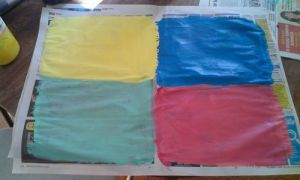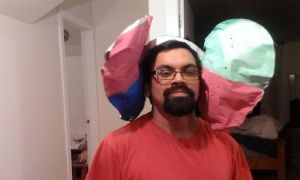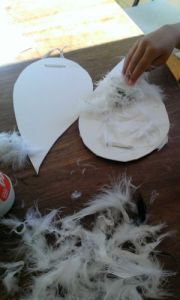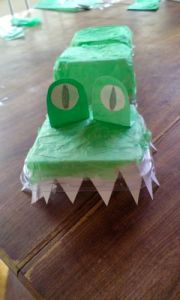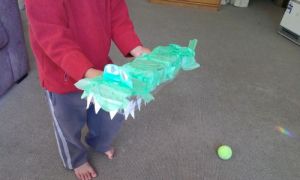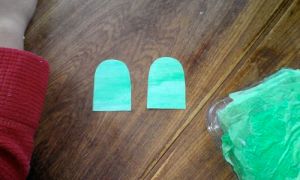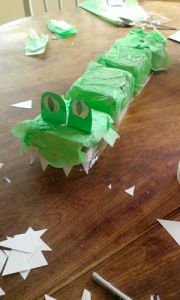E is for Elmer elephant ears
September 5, 2013
These we initially going to just be elephant ears, until my son had the bright idea of making them colourful and then they became Elmer ears. 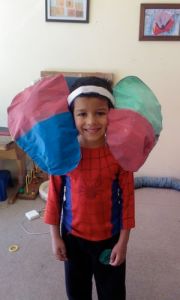
You will need
- Sheets of newspaper or butchers paper or any paper that is about A3 size
- Paints of various colours
- Stapler
- Sticky tape
- Scissors
- Texta or pencil to draw the ear shape
Method
Spread out a sheet of newspaper and using four different colours paint rough squares/rectangles of colour onto it.
Repeat this a second time, you can use the same pattern of colours or different ones. My sons preference was to use handprints to paint the paper! Leave both sheets to dry. Once they have dried fold the paper in half widthwise, I just used the original fold in the newspaper, and using the texta or pencil draw an approximate elephant ear shape. Make the folded edge the side of the ear that goes against the side of the head.
Cut out the ear then staple around the edge but leave a small gap at the top, and you don’t need to staple along the fold. Scrunch up newspaper and stuff the ear, then staple the hole shut and check around the ear to see if a few more staples are needed now that the ear is stuffed. Repeat this process for the other ear.
Once you have the two ears, make a headband from another piece of paper. We took a sheet of newspaper and folded it repeatedly lengthwise until it was about an inch wide. Measure it around the childs head and use some sticky tape to make a headband the right size. Sticky tape works best here as it doesn’t rub against the children’s heads like staples can do.
Staple the folded edge on the now stuffed ears onto the headband. You will need a few staples and it might be best to cover them in sticky tape to avoid them scratching the children’s heads.
Try them on! They might be popular with other members of the family too!!
Tips/notes/other ideas
We added some white paint to the colours to make them thicker so you can’t see as much of the print through it. We just chose to make four squares of colour on each ear, you could make any sort of design. Making these from thicker paper would make them last longer, they were popular with all the children and adults too!
D is for duck wings
June 21, 2013
Just a quick warning these will not help your children to fly even if they think they will! You might need to state that at the beginning, these are just for pretend 🙂
You will need
- Card, cereal boxes would work
- sewing elastic
- Glue
- Feathers ( I pulled some feather boas apart but you can find bags of feathers in craft stores)
- A hole punch or scissors and blue tac
- Scissors
- Pencil
Method
Draw freehand on the card a wing shape, mine looked like this but the children might have their own ideas, and they can be what ever size they want but bigger is more fun!
I had to cut out the shape as the card I used was too thick for my son to even attempt it, but the children can have a go if they can manage it. Then make two holes at least an 5cm apart in the top of each wing. If the card is thin enough this can be done with a hole punch but if it is too hard adult help is required. Place a ball of blue-tac under the wing where you want to make the holes and push a pair of scissors through the card into the tac to make a hole, this protects fingers and tables from damage, but has to be done by an adult. Then thread a piece of elastic through the holes and tie off to make a loop. To get the right amount of elastic I measured it round my sons upper arm, and cut the required length.
Next come the rather messy part. Cover the wing in glue and stick feathers all over it, trying hard not to stick feathers to fingers and table tops. Leave them to dry and then shake off any excess feathers before they get spread round the house by enthusiastic children! Slide the elastic up their arms and I suggest letting them ‘fly’ round the garden for a bit.
(Jumping off the sofa and flapping hard to see if he could fly and glide)
Tips/notes/other ideas
Just make sure the elastic is not too tight on their arms as this will lead to loss of circulation to their hands and fingers! With my wing shape I made the longer, straighter edge the ‘top’ edge and this is what went along the arm with the rest of the wing curving behind, but the children might have completely different ideas. You could always have various colours of feathers and make them parrot wings instead. Finally thank you to my sons school teacher who came up with the original idea for a school production.
C is for crocodiles
May 21, 2013
Preferably with lots of teeth!
You will need
- Two washed fruit containers ( we used cherry tomato and strawberry containers from the local supermarket) preferably with one side deeper than the other when you open it up. You need two per crocodile
- Green tissue paper torn into strips
- glue
- Green and white card
- A circle template and and eye template ( see below) ,or have these already cut out for the children
- A pencil
- Sticky tape
Method.
Turn the containers over and stick the two deepest halves together, then turn it back over and cover the container with the tissue paper, using lots of glue to stick it down!
As it is drying cut out the teeth and the eyes. For the teeth simply cut some triangle shapes from the white card, and when the crocodile is dry use sticky tape to stick them on the inside of the crocodiles mouth. It is easier to do this before gluing on the eyes.
( My son insisted that his crocodile had to have teeth all the way round his mouth! )
For the eyes cut out two of these shapes,
from the green card and fold about 5-10mm of the bottom over, this is to glue them on with. Cut circles from the white card using a template ( I used a 10c coin) and stick them onto the green. Draw on the pupil of the eyes, remembering that crocodiles have eyes like cats, and then using the folded end glue them onto the head of the crocodile.
Tips/notes/other ideas
If the children are capable of cutting with scissors they can cut out their own crocodile eyes, they might not be exact but they will be individual. If not you might have to have these eyes already prepared, or at least the separate parts which they can then glue together. If you are waiting for the bodies to dry you could read ‘The Enormous Crocodile’ by Roald Dahl to pass the time!
